Admiral Sampson

Admiral Sampson 2009
It was the day before the dive to the Admiral Sampson in 320 feet of salt water. I had been drinking water all day for maximum hydration, although I was never sure if it truly helps to hydrate the day before a dive. Oh well, it sounds good; but I did cheat a little by having a beer with dinner.
I didn’t sleep well that night, even though I went to bed with the intent of having at least 7 hours of sleep. My mind was racing, excited about the coming day’s dive.
My gear had been thoroughly checked and rechecked, orings cleaned and lubed, batteries charged, and all of it neatly packed in my car. I will be picking up Josh at 5:45 am the next morning.
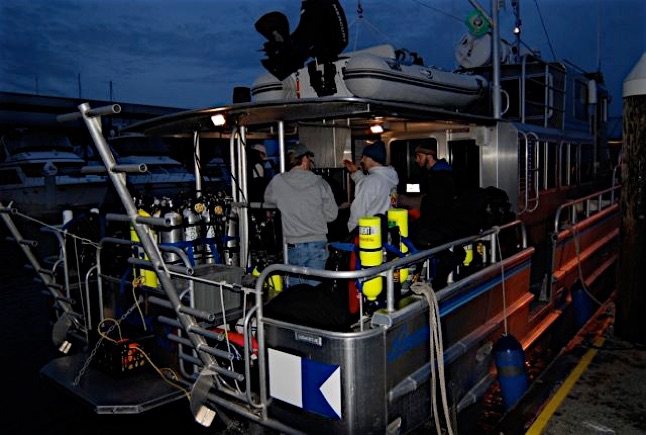
We made it up to Edmonds Marina by 6:20 am and started loading our gear aboard the boat. We were the first ones there, so we got prime seating on the Mark V, Mike Fergussen’s custom dive vessel. Randy Williams wasn’t far behind us, and pretty soon the rest of the hooligans started showing up. There were going to be 6 divers attempting the Sampson; myself, Ron Akeson, Randy Williams, Mark Theune, Rob Wilson, and Paul Hangartner. Aboard we had 2 safety divers, Josh Smith, and BJ Nussbaum, with Cuppie and one of Mike’s crew being the first rate deck hands.



With a stunning sunrise peeking through the clouds, we motored out on glassy seas.
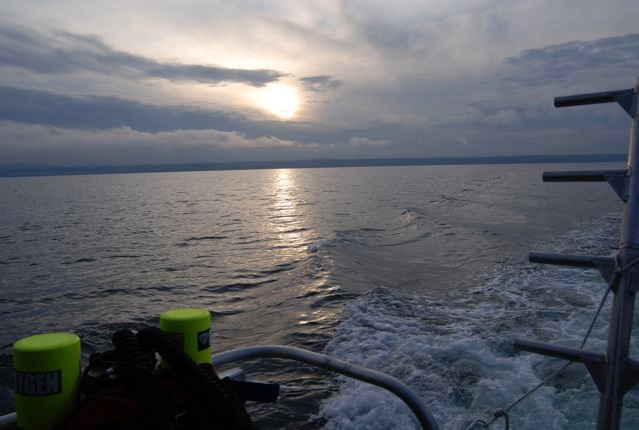
It took us about an hour to get out on site. VTS had been notified of our dive plan months in advance, and they notified us over the radio that they would redirect the large ship coming our way, so that we could conduct our diving operations; Very considerate and professional.

The crew prepared for the drop, while Captain Mike positioned us over the wreck.



The water was still glassy and clear, and everyone was optimistic. I don’t know how many drop attempts there were, I think about 3 until we finally snagged something. When you put a buoy in the water that is attached to one of these wrecks, you really can see the force of current by watching the wake on the backside of the buoy. This one had some wake-not slack yet.
We motored back around, attached the deco station, and geared up, all the while keeping a sharp eye on those buoys.
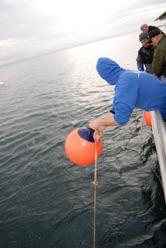


The deco station is connected via carabineer to the main line that is grappled to the wreck. At that carabiner is a weight, so that the carabiner can slide up and down the main line. When there is ripping current, the carabiner and weight rise up the main line and the deco station is far away from the main line, when current stops, the carabiner falls due to the weight and that pulls the deco station closer to the main line. The deco station and main line both have buoys, so you can easily watch how close you are getting to slack by how close the deco station has come back to the main line. Problem is though, at this location there are some wicked bottom currents due to the bottom topography that no buoy can show us at the surface.
Our predicted slack was approaching, but the buoys were still pretty far apart.

We have been here before and seen this, where slack has been off an hour, never slacked, or looked slacked till we neared the bottom. This current area, so I have been told, can be "thrown off kilter" by pressure systems and weather, as well as numerous other topographical anomalies. We were wondering if this was going to be another weather phenomenon.
Slack was upon us, with no real change in water flow, so we decided to try it, and see if it slowed while we were in the water. Randy and Mark jumped in first. Ron was a part of that team, but lack of sleep the week before due to a lot of work at his dive shop, Ron decided not to join. Randy and Mark made it to the buoys and held on. Then of course Murphy’s Law struck. Randy’s light, although tested on the boat, didn’t fire. Knowing that he had a backup on the boat, he called for us to come back around to change out his light.
Randy finally got back on board and changed out his light. That one didn’t strike either. There was a bit of cursing to the Gods. It looked like Randy’s luck might have run out.

Our team jumped in next and we scootered over to the buoys.
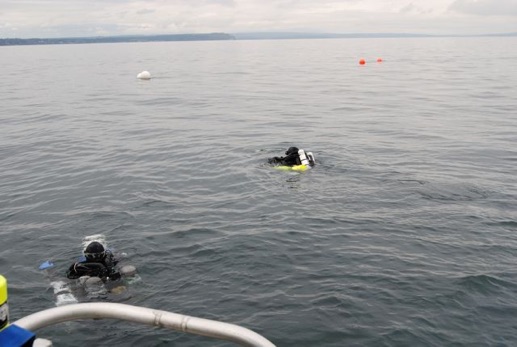
The current was still moving a bit, but with the CUDA and my big ol' camera on board I had NO problem staying at the buoy. This dive was actually why I got the CUDA in the first place-no more losing against current. We stayed on the surface at the buoy for about 5 minutes waiting for the current to slow a bit, but it didn’t.

We got back on board the Mark V and decided to wait a little more to see if the current slowed. It was obvious the waters off Point No Point weren’t following the current charts. Slack was late. We sat on board for about 10 minutes, and noted that if we wanted to make the dive we would have to go soon, because Randy and Mark would be on their way up shortly, and they would release the deco station, then we’d have to do our deco holding near the main line (in possible ripping current) or blow bags and float around the shipping lanes with just our little SMB’s to warn the container ships of our position. Neither option sounded very enticing.

Just then we noticed the buoys getting closer: time to go! We jumped back in, and the current was still moving, but manageable with scooters.
As we descended we noticed how clear the water was, and visibility was about 30- 40 ft. At around 200 ft the current subsided and we were in still water-AWESOME! Just then we spotted Randy and Mark on their ascent, and relayed to them to not detach the deco station, then we continued down.
Finally after 7.5 minutes of descent, I saw the wreck come into view. What a sight!!! We were snagged right on the bow, literally right on the tip of the stem. Nice work, crew!!
We hung our strobe and continued aft to explore the bow section. The Admiral Sampson is split in two with the bow on an even plain while the stern is on its side. The deck at the bow has collapsed and we poked around the wreckage below at 320 feet. The windlass was down there with chain still attached, Randy said he saw the anchor, but I didn’t get any footage of it.
We spent the next few minutes poking around in the collapsed deck, and then I made the call to continue aft. The top deck wasn’t collapsed the further towards the stern you went. I passed the fore mast and remnants of the rooms below the pilot house. Just past the mast and in the corner of what looked like a cabin, lay a single open porthole. I grabbed it to pull it out to get a better shot, and was taken aback of how heavy it was. It was much smaller than the ones I’ve seen on the Governor, but it was hard to move. I sat there for a while just looking at it, wondering who was the person to open it, or who was the last person to gaze out of it on this last doomed voyage.
We scootered around a bit more, and were a bit surprised to see more of the small Metridium Senile instead of the larger Gigantium all over the wreck. For a wreck that has been down since 1914, there were a lot of spots devoid of life. There were the expected Rockfish, though smaller than I expected, cowering in the nooks and crannies, darting out when we brushed by. We continued exploring big holes and sections that were big enough to get into, until we got near our time to leave.
We were diving a mixed team, and our bottom time was dependant on the open circuit guy. 15 minutes max on the bottom, which gave him around 110 minutes of decompression. Paul is searching for a rebreather as I speak. I used approximately 800 psi of Diluent and close to the same in O2 in my steel 19’s, Gotta love that!

We got back on the boat a bit colder, but high fives were given all around for another excellent dive!!
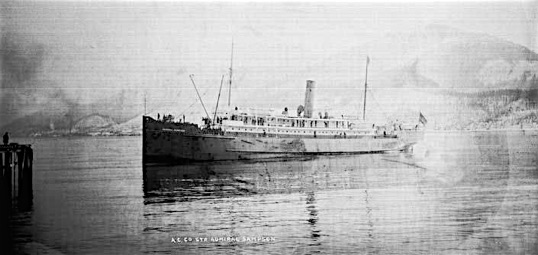
Courtesy Alaska State library



-
-Home
